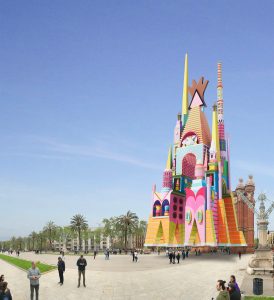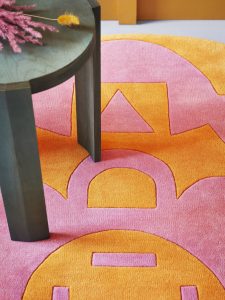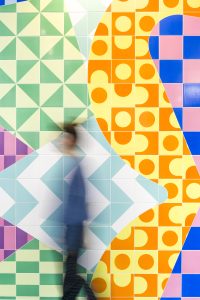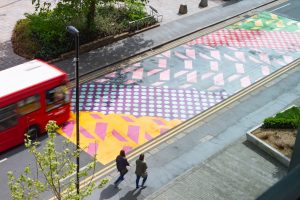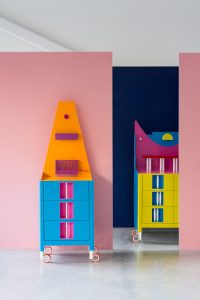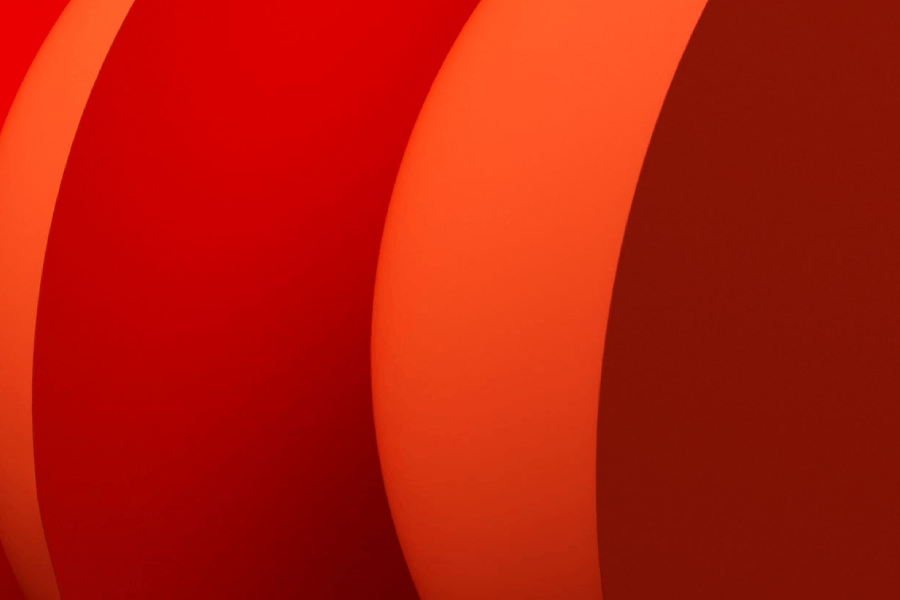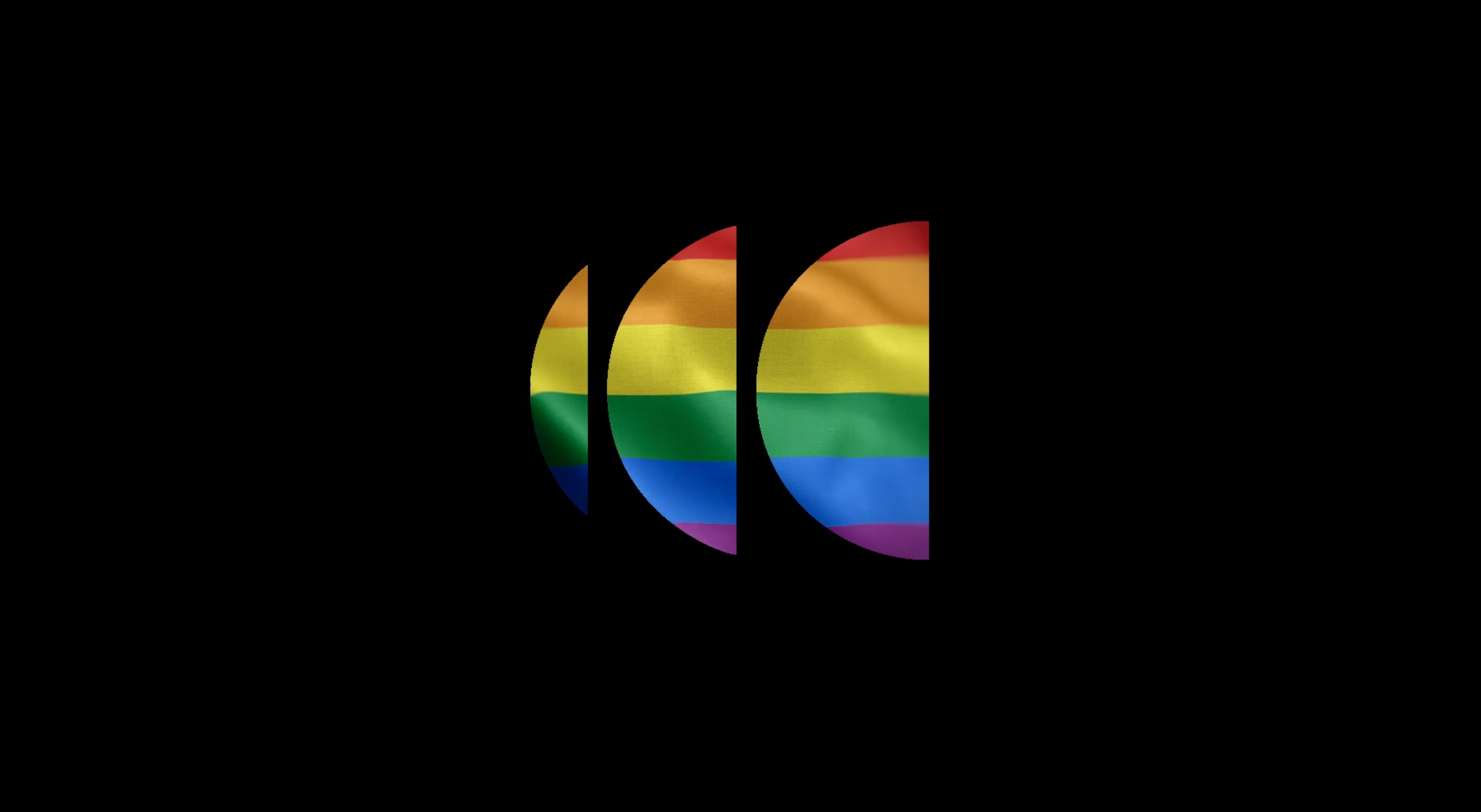
Celebrating Pride and the LGBTQIA+ community is an all-year-round commitment, so we’ve curated a special spotlight series where we chat with the visionary creatives in our far-reaching communities, to learn more about what they do, why they do it, and what value Pride holds for them.
Artist and designer Adam Nathaniel Furman pulls us into their prismatic world to talk about the necessity of a shared history for the queer community, and how they’ve built a livelihood from their art. Adam uses they/them pronouns.
When did you first realise you wanted to become a designer, and what were the driving factors to making it a reality?
From a young age, I was extremely interested in material things – the way things look, the way things feel. The world we live in is filled with things we make, filled with buildings we design and build – it’s a busy world, it’s so noisy! The world of inanimate things is also mute. It’s quiet; it can be serene, delicate and elegant. Objects don’t speak but to me – a chubby gay kid who didn’t really have many friends – they were totally accessible. They spoke to me. They were like my friends. I felt like I could converse with them, I could express myself through the objects I made and create a safe place that I felt happy in.
I therefore developed this love of making from an early age. I went to Central Saint Martins to do a foundation course and there I met a fantastic teacher who encouraged me to study spatial design. I ended up studying architecture. Luckily, the architectural school I attended was very multidisciplinary. We didn’t just do architecture. We could build furniture in the workshop if we wanted to. We could design and craft products. My love of making was further nurtured in this environment.
I graduated into the world of architecture, I continued to design products and make sculptural objects on the side whilst working for various architectural practices. I eventually built a substantial portfolio of my own work. I didn’t realise then but this was the side that really connected me back to my childhood passion. People started coming to me with projects and I ended up with my own creative practice.
How do you champion Pride in your work?
Constantly. On a very superficial level, I have fashion products that are made specifically for Pride to support charities that I care about. My practice has always been resolutely and unapologetically queer, which has led me to being marginalised for a long time. Queerness is a fundamental part of how I approach and discuss my work and how my ideas form. Only recently, has queerness been picked up as a positive attribute, leading to commissions that I could have only dreamed of a few years ago.
There has been a sea of change in the design industry. People are showing genuine interest in queerness; they are open to new ideas; they are more willing to have difficult conversations. I think that recent movements like Black Lives Matter have helped to shake up people from stupor and complacency, leading to a more open-minded engagement in general. People are beginning to question the structure of our society and their place within it. Many people have seen how badly black people are treated in the US and realised the same for many other groups of people, including queer people. The change is perhaps slower in the UK but I have a lot of faith in the British public. Back in 2019, for instance, I was invited to write an essay on queerness for Architectural Review. My essay generated a lot of comments and responses. Spearheaded by editors, curators, academics and activists, we are given more and more platforms to speak up and that is great.
What value do you believe diversity, inclusion and representation to bring to the Creative Industries?
In a liberal society, the point has been made for many decades now that it is critical for all professions, in politics, in civil and legal services, to have people from all different backgrounds providing a variety of perspectives on various matters. The same can be applied to the creative industry; it’s beneficial to make sure that industry is open and inclusive, benefitting all people, promoting the full range of good intentions that most things are created with. If we have more representations from diverse groups of people (and this would not be hard to do because Britain is full of talents!), then design will be more loved and appreciated because so many more people feel reflected and represented in the work they see.
The design industry in the UK will become richer, stronger, more dynamic, more sustainable by having all the different groups bringing in their unique perspectives. We should not have to fight for space. I think that people can feel threatened when they hear words like ‘diversity’ because they feel they will be pushed away or their own rights will be squandered. That is not the case. Diversity enriches and expands the design industry. It makes sense for industry to be more inclusive, especially considering that the creative sector is one of the growth areas of our current economy.
Is there more that needs to be done to ensure LGBTQIA+ creatives and talent have equal opportunity in the design industry?
Absolutely. There are certain people – some of my peers – who present themselves as having sort of appeared out of nowhere and their work not being based upon any particular references or people they admire. But we’re all creatures of context. If you’re part of a community, you inevitably absorb a lot of its history, a lot of its references, a lot of what’s unique about the community. If you’re a new designer, and depending on what communities you’re part of, you inevitably absorb all these references, maybe unconsciously, and channel them back into your work. I think that’s beautiful.
Queer people around my age, queer people from London, would have a similar context in developing their queer identity. The world is changing fast, however, so the context would be quite different for the younger queer generations, Gen-Z, for example, or for queer people from Manchester. Design changes a lot from generation to generation but I also think there are a lot of differences and similarities within generations. A Bengali Muslim queer person will have a wonderful mixture of associations and references in their work from their own cultural background but they will also have some overlap with other queer people from different cultural backgrounds or different cities. I think there are multiple ways of seeing and expressing; they are all valid. There should be space for designers from all backgrounds to coexist.
Do you think the Creative Industries can be the solution to societal challenges? And if so, how?
Not in the sense that one industry can be the solution for everything. But yes, to show that inclusivity and diversity are beneficial. It’s about representation as well, being around the table, being part of the discussions. I don’t like using this term so much as it has been hijacked by a certain group of people but cognitive diversity allows for different types of brains to be present at the table to see problems from all different angles to find the best solutions possible.
We had one group of experts designing car-centric cities in the 1960s with a disastrous result – our cities were flattened for highways, because everything was about the car. Imagine if there had been others around the table; artists, designers, architects, heritage people, representing a much broader base than what had been, with only politicians, transport managers and engineers.
It’s exciting to hear the Mayor of London talk about moving towards a zero-carbon future as an exciting opportunity to make our cities a better place to live. That’s how the Mayor of Paris sees the future of Paris, too. You cannot do this without getting the design industry around the table. It’s vital that artists and designers are taken more seriously and included in all the discussions.
Give a shoutout to an LGBTQIA+ creative or organisation that makes a difference in the world.
Oh there are so many! LGBTIQ Outside is a community-led grassroots homeless shelter for queer people and queer youth. It’s astonishing how they have managed to create this very inspirational organisation out of nothing. They have been kicked out of places many times over but they are resilient and they find new places to take care of the most vulnerable people in the queer community in London. Then I would also flag up Dr Ben Campkin (he/him) and Dr Lo Marshall (they/them) at UCL, who Josh Mardell and I collaborated with on the production of our book Queer Spaces. The two academics are absolutely cutting-edge in the world of queer issues in relation to spatial justice and politics, and how legislation and planning policies interface with queer oppression. They are also very supportive of queer spaces and queer communities. Ben is just about to come out with a very ground-breaking book on all these issues, it’s driven by deep academic research and it’s of the ilk of LGBTIQ Outside. In London, we have the most amazing people working in charities, doing research work and making a real difference in queer spatial politics, especially in relation to architecture and design. Their work is intimately tied in with bringing real changes to real people’s lives.
This year’s theme for Pride is ‘Looking Back and Moving Forward’. What does this evoke for you?
I think that phrase is very relevant to the kind of work that Josh (Mardell) and I do together, as well as Ben (Campkin) and Lo (Marshall). I think that for people whose history has been told many times over, whose material history is readily accessible, don’t really understand how profoundly destabilising it is not to have a history that is unique to us readily accessible. Being connected to one’s past gives one the strength to move forward. Without the past, you are never sure of yourself, you don’t have a ground to stand on. You don’t know where you belong.
Queer history has been incredibly repressed over the past couple of hundred years, to the point where conducting archival work on the subject is extremely hard because even when people’s diaries have survived, their families might have burnt them out of shame. Their interiors and private spaces are forever lost. We know that there was so much profound creativity going back to the 1750s, equating to what we call queer space, queer space-making and queer design, but it has been always purposefully ridiculed and othered.
These spaces have been kept hidden, kept out of history-making. They were never documented properly. The only documentation we may have of queer lives from the past is through police reports, when queer people were arrested. That’s very sad.
On top of that, queer people are not part of an ethnic group. If you’re from a certain ethnic group, the culture is a given, whether you want it or not. You choose to accept or reject it. Queer people are very unusual in human history, because very few of them would have been fortunate enough to be born into queer families. They must therefore figure out what is ‘wrong’ with them, or what is “right” for them, learn to accept that they are different from the loved ones around them, and this is incredibly hard. It’s also very hard to find other people like them, who are trying to find their place in the world that is hostile to them, let alone find their own history.
There’s a kind of perennial yearning within queer culture, from generation to generation: a yearning for a sense of history, to be connected to a deep lineage of some kind. This is why archives are so important in queer history, why heirlooming is vital to queer history. This idea of passing on part of yourself – your learnings, your knowledge, your traditions – to another generation. The younger people crave that as well. One of the ways that we’ve heirloomed throughout history is through books, but there wasn’t anything on architecture and design until very recently. It’s very nice to see a flurry of queer activities in architecture specifically intended to provide young queer people access to a shared history. They can now be empowered and not have to always reinvent the wheel or have to argue the right for their very existence.
So, in order to move forward, you need to have history. This is especially important in queer discourse where so much of it has been systematically erased over the past few hundred years. It’s good to see that there’s a renewed source of energy coming from within the community and also from its allies to consume history and knowledge around queerness.
What does creativity mean to you?
Safety. It’s my safe space. Growing up, creativity was the one part of life I could control and was good at. It made me happy. I felt calm. It’s my happy, queer space. It’s a beautiful thing to have been lucky enough to be born with the brain and hands that can create a world in which I can step into and be content in, from which I can make a living, a life, a business. I am grateful for all that. It means the absence of fear and happiness, to a degree.
You can catch Adam’s latest work, Click Your Heels Together Three Times, at Canary Wharf, London, as part of the community’s Pride activity from Thursday 29 June!
Related stories

